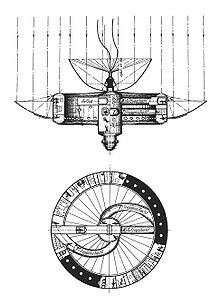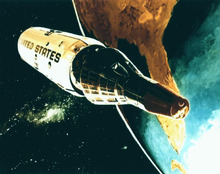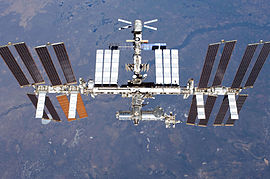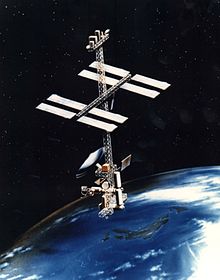- Space station
-
A space station (or orbital station) is a spacecraft capable of supporting a crew which is designed to remain in space (most commonly in low Earth orbit) for an extended period of time, and to which other spacecraft can dock. A space station is distinguished from other spacecraft used for human spaceflight by its lack of major propulsion or landing facilities. Instead other vehicles transport people and cargo to and from the station. As of October 2011[update] two space stations are in orbit; the International Space Station, and China's Tiangong 1.[1] Previous stations include the Almaz and Salyut series, Skylab and most recently Mir.
Space stations are used to study the effects of long-term space flight on the human body as well as to provide platforms for greater number and length of scientific studies than available on other space vehicles. All space stations have been designed with the intention of rotating multiple crews, with each crew member staying aboard the station for weeks or months, but rarely more than a year. Since the ill-fated flight of Soyuz 11 to Salyut 1, all manned spaceflight duration records have been set aboard space stations. The duration record for a single spaceflight is 437.7 days, set by Valeriy Polyakov aboard Mir from 1994 to 1995. As of 2011[update], three astronauts have completed single missions of over a year, all aboard Mir.
Space stations have been used for both military and civilian purposes. The last military-use space station was Salyut 5, which was used by the Almaz program of the Soviet Union in 1976 and 1977.[2]
Contents
History
Early concepts
 Description of a space station in Herman Potočnik's The Problem of Space Travel (1929).
Description of a space station in Herman Potočnik's The Problem of Space Travel (1929).
(Legend: Aufzugschacht: elevator shaft. K: electric cable to an external observatory. Kondensatorrohre: condenser pipes. S: airlock. Treppenschacht: stairwell. Verdampfungsrohr: boiler pipe).Space stations have been envisaged since at least 1869 when Everett Hale wrote about a 'brick moon' in Atlantic monthly magazine.[3] Space stations were also later envisaged by Konstantin Tsiolkovsky and Hermann Oberth.[3]
In 1929 Herman Potočnik's The Problem of Space Travel was published. This remained popular for over 30 years. In 1951, in Collier's weekly, Wernher von Braun published his design for a wheel-shaped space station.[3]
During Second World War German scientists researched an orbital weapon that could utilize the sun's energy. This so-called "sun gun" would be part of a space station orbiting Earth at a height of 5,100 miles (8,200 km). [4]
When Apollo 11 landed on the Moon in July 1969, the United States won the race to the Moon over the Soviet Union.[5] This caused the Soviet Union to look for other ways to show their spaceflight capabilities.[5]
Salyut, Almaz, and Skylab (1971-1986)
The first space station was Salyut 1, which was launched by the Soviet Union on April 19, 1971. Like all the early space stations, it was "monolithic", intended to be constructed and launched in one piece, and then manned by a crew later. As such, monolithic stations generally contained all their supplies and experimental equipment when launched, and were considered "expended", and then abandoned, when these were used up.
The earlier Soviet stations were all designated "Salyut", but among these there were two distinct types: civilian and military. The military stations, Salyut 2, Salyut 3, and Salyut 5, were also known as Almaz stations.
The civilian stations Salyut 6 and Salyut 7 were built with two docking ports, which allowed a second crew to visit, bringing a new spacecraft with them; the Soyuz ferry could spend 90 days in space, after which point it needed to be replaced by a fresh Soyuz spacecraft.[6] This allowed for a crew to man the station continually. Skylab was also equipped with two docking ports, like second-generation stations, but the extra port was never utilized. The presence of a second port on the new stations allowed Progress supply vehicles to be docked to the station, meaning that fresh supplies could be brought to aid long-duration missions. This concept was expanded on Salyut 7, which "hard docked" with a TKS tug shortly before it was abandoned; this served as a proof-of-concept for the use of modular space stations. The later Salyuts may reasonably be seen as a transition between the two groups.
Mir (1986-1998)
Unlike previous stations, the Soviet space station Mir had a modular design; a core unit was launched, and additional modules, generally with a specific role, were later added to that. This method allows for greater flexibility in operation, as well as removing the need for a single immensely powerful launch vehicle. Modular stations are also designed from the outset to have their supplies provided by logistical support, which allows for a longer lifetime at the cost of requiring regular support launches.
ISS (1998-present)
The core module of the International Space Station was launched in 1998.
The ISS is divided into two main sections, the Russian orbital segment, and the United States operational segment (USOS).
USOS modules are brought to the station by the Space Shuttle and manually attached to the ISS by crews during EVAs. Connections are made manually for electrical, data, propulsion and cooling fluids. This results in a single piece which is not designed for disassembly.[7]
The Russian Orbital (ROS) segment's modules are able to launch, fly and dock themselves without human intervention using Proton rockets.[8] Connections are automatically made for power, data and propulsion fluids and gases. The Russian approach allows assembly of space stations orbiting other worlds in preparation for manned missions. The Nauka module of the ISS will be used in the 12th Russian(/Soviet) space station, OPSEK, whose main goal is supporting manned deep space exploration.
Russian Modular or 'next generation' space stations differ from 'Monolithic' single piece stations by allowing reconfiguration of the station to suit changing needs. According to a 2009 report, RKK Energia is considering methods to remove from the station some modules of the Russian Orbital Segment when the end of mission is reached for the ISS and use them as a basis for a new station, known as the Orbital Piloted Assembly and Experiment Complex. None of these modules would have reached the end of their useful lives in 2016 or 2020. The report presents a statement from an unnamed Russian engineer who believes that, based on the experience from Mir, a thirty-year life should be possible, except for micrometeorite damage, because the Russian modules have been built with on-orbit refurbishment in mind.[9]
Tiangong (2011-present)
China's first space station, Tiangong-1 was launched in September 2011. The unmanned Shenzhou 8 then successfully performed an automatic rendezvous and docking in November 2011. The manned Shenzhou 9 and Shenzhou 10 are expected to visit Tiangong-1 in 2012. Two more space stations, Tiangong 2 and Tiangong 3 are expected to be launched in subsequent years, paving the way for the construction of a larger space station around 2020.
Habitability issues
These stations have various issues that limit their long-term habitability, such as very low recycling rates, relatively high radiation levels and a lack of gravity. Some of these problems cause discomfort and long-term health effects. In the case of solar flares, all current habitats are protected by the Earth's magnetic field, and are below the Van Allen belts.
Future space habitats may attempt to address these issues, and are intended for long-term occupation. Some designs might even accommodate large numbers of people, essentially "cities in space" where people would make their homes. No such design has yet been constructed, since even for a small station, the current (2010) launch costs are not economically or politically viable.
Possible ways to deal with these costs would be to build a large number of rockets (economies of scale), employ reusable rockets, In Situ Resource Utilisation, or non-rocket spacelaunch methods such as space elevators. For example, in 1975, proposing to seek long-term habitability through artificial gravity and enough mass in space to allow high radiation shielding, the most ambitious historical NASA study, a conceptual 10000-person spacestation, envisioned a future mass driver base launching 600 times its own mass in lunar material cumulatively over years.[10]
Architecture
A space station is a complex system with many interrelated subsystems:
- Structure
- Electrical power
- Thermal control
- Attitude determination and control
- Orbital navigation and propulsion
- Automation and robotics
- Computing and communications
- Environmental and life support
- Crew facilities
- Crew and cargo transportation
List of space stations
The Soviet space stations came in two types, the civilian Durable Orbital Station (DOS), and the military Almaz stations.
(dates refer to periods when stations were inhabited by crews)
- Salyut space stations (USSR, 1971–1986)
- Salyut 1 (1971, 1 crew and 1 failed docking)
- DOS-2 (1972, launch failure)
- Salyut 2/Almaz (1973, failed shortly after launch)
- Cosmos 557 (1973, re-entered eleven days after launch)
- Salyut 3/Almaz (1974, 1 crew and 1 failed docking)
- Salyut 4 (1975, 2 crews and 1 planned crew failed to achieve orbit)
- Salyut 5/Almaz (1976–1977, 2 crews and 1 failed docking)
- Salyut 6 (1977–1981, 16 crews (5 long duration, 11 short duration and 1 failed docking)
- Salyut 7 (1982–1986, 10 crews (6 long duration, 4 short duration and 1 failed docking)
- Skylab (USA, 1973–1974, 3 crews)
- Mir (USSR/Russia, 1986–2000, 28 long duration crews)
- International Space Station (ISS) (United States, European Space Agency, Japan, Russia, and Canada 2000–ongoing, 27 long duration crews as of April 2011)
- Tiangong 1 (China, 2011–ongoing)
Space station Crew size Launched Reentered Days in use Total crew
and visitorsVisits Mass Pressurized
volumeName Image In orbit Occupied Manned Unmanned Salyut 1


3 19 April 1971
01:40:00 UTC11 October 1971 175 24 3 2 0 18,425 kg (40,620 lb) 90 m³
(3,180 ft³)DOS-2


0 29 July 1972
Failed to reach orbit29 July 1972 0 0 0 0 0 18,000 kg (40,000 lb)[11] 90 m³
(3,180 ft³)Salyut 2
(Almaz 1)


0 4 April 1973 28 May 1973 54 0 0 0 0 18,500 kg (41,000 lb)[12] Cosmos 557


0 11 May 1973 22 May 1973 11 0 0 0 0 19,400 kg (43,000 lb)[11] Skylab


3 14 May 1973
17:30:00 UTC11 July 1979
16:37:00 UTC2,249 171 9 3 0 77,088 kg (169,950 lb) 283 m³
(10,000 ft³)Salyut 3
(Almaz 2)


2 25 June 1974
22:38:00 UTC24 January 1975 213 15 2 1 0 18,900 kg (42,000 lb)[6]
(at launch)90 m³
(3,180 ft³)Salyut 4


2 26 December 1974
04:15:00 UTC3 February 1977 770 92 4 2 1 18,900 kg (42,000 lb)[6]
(at launch)90 m³
(3,180 ft³)Salyut 5
(Almaz 3)


2 22 June 1976
18:04:00 UTC8 August 1977 412 67 4 2 0 19,000 kg (42,000 lb)[6]
(at launch)100 m³
(3,530 ft³)Salyut 6


3 29 September 1977
06:50:00 UTC29 July 1982 1,764 683 33 16 14 19,000 kg (42,000 lb) 90 m³
(3,180 ft³)Salyut 7


3 19 April 1982
19:45:00 UTC7 February 1991 3,216 816 26 12 15 19,000 kg (42,000 lb) 90 m³
(3,180 ft³)Mir
 /
/ 

3 19 February 1986
21:28:23 UTC23 March 2001
05:50:00 UTC5,511 4,594 137 39 68 124,340 kg (274,100 lb) 350 m³ (12,360 ft³) ISS
 /
/  / ESA /
/ ESA /  /
/ 

6 20 November 1998 Currently in orbit 4750 4039 216 76 53 417,289 kg (919,960 lb) 907 m³ (32,030 ft³) Tiangong 1


3 29 September 2011
13:16:03.507 UTCCurrently in orbit 54 0 0 0 1 8,506 kg (18,750 lb) 15 m³ (530 ft³) Prototypes
Space station Crew size Launched Reentered Days in use Total crew
and visitorsVisits Mass Pressurized
volumeName Image In orbit Occupied Manned Unmanned Genesis I
(Private)
0 12 July 2006 Currently in orbit 1959 0 0 0 0 1,360 kg (3,000 lb) 11.5 m³ (406 ft³) Genesis II
(Private)
0 28 June 2007 Currently in orbit 1608 0 0 0 0 1,360 kg (3,000 lb) 11.5 m³ (406 ft³) - ISS statistics as of 9 December 2009

Canceled projects
- United States Air Force Manned Orbiting Laboratory project, canceled in 1969 about a year before the first planned test flight; this was unusual in being an explicitly military project, as opposed to the Soviet Almaz program, which was heavily intertwined with, and concealed by, the contemporaneous Salyut program.
 Gemini B reentry module separates from the MOL. 1967 conceptual drawing using Gemini reentry spacecraft. (USAF)
Gemini B reentry module separates from the MOL. 1967 conceptual drawing using Gemini reentry spacecraft. (USAF)
- A second Skylab unit (Skylab B) was manufactured, as a backup article; due to the high costs of providing launch vehicles, and a desire by NASA to cease Saturn and Apollo operations in time to prepare for the Space Shuttle coming into service, it was never flown. The hull can now be seen in the National Air and Space Museum, in Washington DC, where it is a popular tourist attraction.
- A number of additional Salyuts were produced, as backups or as flight articles that were later canceled.
- The U.S. Space Station Freedom program, which, despite being under development for ten years, was never launched, evolved into the International Space Station
- The Soviet/Russian Mir-2 station, which was never constructed, had some of its elements incorporated into the International Space Station.
- The Industrial Space Facility was a station proposed in the 1980s that was to be privately funded. The project was canceled when the company created to build it, Space Industries Incorporated, was unable to secure funding from the United States government.[13]
- The European Columbus project planned to create a small space station serviced by the Hermes shuttle. It evolved into the ISS Columbus module.
Future developments
- The People's Republic of China is expected to launch two more space labs called Tiangong 2 and Tiangong 3 before 2016. It will then launch a three module 60-ton space station by 2022. Project 921-2 is the working name given by the People's Republic of China for plans to create a manned space station. The public is being asked to submit suggestions for names and symbols to adorn the space station.[14]
- U.S. company Bigelow Aerospace is developing the Bigelow Commercial Space Station, a private orbital complex. Bigelow proposes to construct the space station using both Sundancer and BA 330 expandable spacecraft modules as well as a central docking node, propulsion, solar arrays, and attached crew capsules. Initial launch of space station components is planned for 2014, with portions of the station available for leased use as early as 2015.[15] Bigelow began to publicly refer to the initial configuration—two Sundancer modules and one BA-330 module—of the first Bigelow station as Space Complex Alpha in October 2010.[16] A second orbital station—Space Complex Bravo—is scheduled to begin launches in 2016.[17] As of February 2011[update], the launches for Space Complex Alpha have been contracted to launch on Atlas V and Falcon 9 launch vehicles, from Cape Canaveral, starting in 2014.[18][19][20]
- In April 2008, the Russian space agency proposed the construction of an orbital construction yard for spacecraft too heavy to launch from Earth directly. It would not begin construction or be finished until after the decommissioning of the International Space Station.[21] This plan was described to ISS partners by Anatoly Perminov June 17, 2009.[22]
- Galactic Suite is the design of a space hotel, which was initially "wished" to be operational by 2012.[citation needed]
- The Orbital Technologies Commercial Space Station is a project of a Russian corporation (Orbital Technologies). The CSS is intended to accommodate diverse functions such as:
- Enabling space-based microgravity research.
- Providing a destination for commercial human spaceflight, space tourism, and state sponsored human spaceflight programs.
- Acting as a backup and emergency safe haven for the International Space Station and its crew.
- Enabling product development.
- Facilitating satellite servicing and maintenance.
- Providing a staging outpost for human space flight missions beyond low Еarth orbit.
- Supplying a uniquely capable remote sensing platform.
The business arrangement for developing and marketing the station was recently clarified by Russian firm Orbital Technologies, who is collaborating to develop the station with the Rocket and Space Technology Corporation Energia (RSC Energia). [23]
- Excalibur Almaz, an international company based in the Isle of Man in the UK and headed by Arthur Dula, is developing a system integrated by a reusable space vehicle and a space station based on the technology of the Soviet military stations "Almaz".[24] In this efforts, Excalibur-Almaz is co-working with a Russian corporation with a large tradition in aerospace technology, the military-industrial association "Mashinostroyenia".[25]
See also
- Kerim Kerimov, lead architect behind earliest space stations
- Lunar outpost
- Lunar space elevator
- Martian outpost
- Propellant depot, future space station complexes may permit spacecraft to refuel
- Rotating wheel space station
- Timeline of Solar System exploration
Notes
- ^ Barbosa, Rui. "China launches TianGong-1 to mark next human space flight milestone". NASASpaceflight.com. http://www.nasaspaceflight.com/2011/09/china-major-human-space-flight-milestone-tiangong-1s-launch/.
- ^ Russian Space Stations (wikisource)
- ^ a b c Boy's Life September 1989 The First Space Station
- ^ Science: Sun Gun. Time Magazine. July 09, 1945. http://www.time.com/time/magazine/article/0,9171,852344-1,00.html.
- ^ a b Ivanovich, p.5
- ^ a b c d D.S.F. Portree (1995). "Mir Hardware Heritage". NASA. http://ston.jsc.nasa.gov/collections/TRS/_techrep/RP1357.pdf. Retrieved 30 November 2010.
- ^ Thomas Kelly, et al. (2000). Engineering Challenges to the Long-Term Operation of the International Space Station. National Academies Press. pp. 28–30. ISBN 0-309-06938-6. http://search.nap.edu/openbook.php?record_id=9794&page=28.
- ^ http://www.usu.edu/mae/aerospace/publications/JDSC_RoadToAutonomy.pdf
- ^ Zak, Anatoly (22 May 2009). "Russia 'to save its ISS modules'". BBC News. http://news.bbc.co.uk/2/hi/science/nature/8064060.stm. Retrieved 23 May 2009.
- ^ NASA, 1975: Space Settlements: A Design Study. Retrieved 2011-05-09.
- ^ a b "Salyut". Encyclopedia Astronautica. http://www.astronautix.com/project/salyut.htm. Retrieved 30 November 2010.
- ^ "Saylut 2". NASA. http://nssdc.gsfc.nasa.gov/nmc/masterCatalog.do?sc=1973-017A. Retrieved 30 November 2010.
- ^ Kaplan, David (August 25, 2007). "Space station idea was far-out at the time". Houston Chronicle. http://www.chron.com/disp/story.mpl/business/5083015.html. Retrieved 2007-08-26.
- ^ Countdown begins for Chineses space station program
- ^ Bigelow Aerospace — Next-Generation Commercial Space Stations: Orbital Complex Construction, Bigelow Aerospace, accessed 2011-01-10.
- ^ Bigelow still thinks big, The Space Review, 2010-11-01, accessed 2011-01-10.
- ^ Balloons in Space: A History, Space.com, 2010-11-12, accessed 2011-01-10.
- ^ Ward, Kenric (2011-02-03). "Nevada Aerospace Company Aims for Florida". Sunshine State News. http://www.sunshinestatenews.com/story/nevada-aerospace-company-aims-florida. Retrieved 2010-02-08. "the North Las Vegas firm announced it intends to launch its first Orbital Space Complex from the Cape in 2014. The inflatable modules would be carried on United Launch Alliance Atlas V rockets. ... By 2017, Bigelow projects a need for 20 to 25 launches per year to send crew and cargo to commercial space stations."
- ^ "SpaceX Launch Manifest". http://www.spacex.com/launch_manifest.php. Retrieved 8 May 2011.
- ^ Choi, Charles (2010-11-12). "In Race for Private Space Stations, It's U.S. Versus Russia". Space.com. http://www.space.com/9518-race-private-space-stations-russia.html. Retrieved 8 May 2011. "Their station could launch by 2015 or so, Gold said, using United Launch Alliance's Atlas 5 rocket or SpaceX's Falcon 9 rocket."
- ^ Прогресс: Россия построит на орбите завод по сборке межпланетных кораблей, Lenta.Ru, April 12, 2008. Accessed on April 13, 2008.
- ^ Doug Messier. "Roskosmos Administrator Perminov Speaks About Past, Present and Future ISS Cooperation". http://www.parabolicarc.com/2009/06/29/roskosmos-administrator-perminov-speaks-present-future-iss-cooperation/.
- ^ Cooperation Agreement with Roscosmos and RSC "Energia"
- ^ Excalibur-Almaz showcases space vehicles and space stations
- ^ ExcaliburAlmaz
References
External links
- Read Congressional Research Service (CRS) Reports regarding Space Stations
- Space Station Newsgroup - sci.space.station
- "Giant Doughnut Purposed As Space Station" early 1950s article on the subject of space exploration and a space station orbiting earth
- - Space Stations
Space stations and habitats Active Defunct Soviet Union
and RussiaUnited StatesCancelled ISS-incorporated Developmental ChinaSpace Complex Alpha · Space Complex BravoRussiaProposed Rotating wheel · Bernal sphere · O'Neill cylinder · Stanford torus · Wet workshop · Space habitat · Industrial Space Facility · Orbital Technologies Commercial Space StationSpace tourism Companies Armadillo Aerospace · Bigelow Aerospace · Blue Origin · EADS Astrium · Mojave Aerospace Ventures · Orbital Sciences Corporation · RocketShip Tours · Scaled Composites · Space Adventures · SpaceX · Virgin Galactic · XCOR Aerospace
Organizations Successful spacecraft Living in space Commercialization of space · Space colonization · Space habitat · Space station · Suborbital spaceplaneSpace competitions Spaceflight lists and timelines General - All spaceflights
- Rocket and missile technology
- Space exploration
- milestones 1957–1969
Human spaceflight General- Manned spacecraft
- (timeline)
- Spaceflights
- 1961–1970
- 1971–1980
- 1981–1990
- 1991–2000
- 2001–2010
- 2011–present
- by program
- Soviet
- Russian
- Mercury
- Gemini
- Apollo
- Shenzhou
- Expeditions
- Spaceflights (manned
- unmanned)
- Spacewalks
- Visitors
- Expeditions
- Spaceflights (manned
- unmanned)
- Spacewalks
- Visitors
- Astronauts (Apollo
- by name
- by year of selection)
- Cosmonauts
- Married couples among space travelers
- Space travelers by name
- Space travelers by nationality
- (timeline)
- Spacewalks and moonwalks (1965–1999
- 2000–present)
- Cumulative spacewalk records
- Spacewalkers
Solar System exploration Earth-orbiting satellites - Climate research
- Communications satellite firsts
- CubeSats
- Earth observation satellites
- (timeline)
- Geosynchronous orbit
- GOES
- Kosmos
- Magnetospheric
- NRO
- TDRS
- USA
Vehicles - Orbital launch systems
- comparison of small lift launch systems
- comparison of medium lift launch systems
- comparison of orbital launch systems
- Sounding rockets
- Spacecraft (unmanned
- manned)
- Upper stages
Launches by rocket type - Ariane
- Atlas
- Black Brant
- Long March
- Proton
- R-7
- Thor and Delta
- Titan
- V-2 tests
Agencies, companies
and facilitiesOther mission lists
and timelinesCategories:- Space stations
- Russian inventions
- Human habitats
Wikimedia Foundation. 2010.


